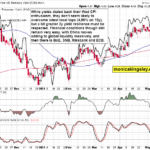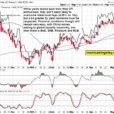
Since the unrest in the Middle East began, nearly all container ships have been rerouted away from the Red Sea/Suez Canal towards the longer route around the Cape of Good Hope (Exhibit 1). For U.S. retailers, this shift has mostly affected their European markets, which include shipments between Asia and Europe. This has added up to two weeks to the normal 35-day trip and created long gaps between the arrivals of vessels in European ports. Moreover, the Panama Canal drought and the Baltimore Bridge collapse have all disrupted regular global supply chains.
Exhibit 1: Red Sea – Cape of Good Hope Route Source: LSEG Workspace map
Source: LSEG Workspace map
Retail consequences
Retailers are telling us that the conflict has caused delays in shipment. Obviously, lead times expanded a bit as shipments had to go around the cape rather than through the Red Sea. Adidas said they experienced shipment delays of two to three weeks.The German retailer also said, “so there is a delay of some of the orders that we could have booked that will now go into Q2 but again, we are not losing the orders because we will get them in Q2 instead of Q1.” The retailer also said that freight companies have increased prices, which they hope “should normalize.” (Source: Adidas FY 2023 Earnings Call, March 2024).Other retailers are citing increased costs. The rise in freight prices also hurt Restoration Hardware in the fourth quarter. The furniture company said, “revenue was negatively impacted by $40 million in the fourth quarter due to the severe January weather and shipping delays related to the ongoing conflict in the Red Sea.” (Source: RH Q4 2023 Earnings Call).Teen retailer Abercrombie & Fitch has been shifting transportation methods to avoid delays: “Obviously, the situation is evolving rapidly. When we think about impact, this is mostly an impact to the European market for us. A lot of shipping goes through that area. Our teams have been reacting, changing modes whenever they need to do to get the product here at the right time at the best price. You’ve seen shipping rates elevate kind of around the world, as this has transpired.” (Source: ANF Earnings Call, Q4 2023).It’s important to note that Abercrombie has seen robust growth, as it registered three consecutive quarters of double digits SSS and strong earnings growth. All are helping the retailer cushion higher shipping rates.Other retailers like Steve Madden are incorporating the risk in their guidance. The shoemaker said, “we mentioned that we have built in based on certain assumptions around Red Sea and everything else around freight, 20 to 25 bps impact to gross margin.” (Source: Q4 2023 Steven Madden Earnings Call).Moreover, retailers have learned a lesson or two from the recent pandemic supply chain issues and have built a bit of inventory. This in turn has helped them make the issues less severe than they otherwise would have been in case of a supply chain disruption.
Most impacted
The automotive industry has been hit hard due to their “just in time” manufacturing processes. Automakers Volvo and Suzuki paused their productions in Europe earlier this year due to delayed deliveries. On January 12, Reuters News released a story stating that Tesla announced suspension of production in Berlin due to transportation delays directly related to the conflict. This was creating disruption in their supply chains. As a result, Volvo and Tesla stock prices took hits, and stock prices remain below last year’s levels, for the most part.
Exhibit 2: Volvo and Tesla Stock Prices
The recent Baltimore bridge collapse also caused brief disruptions and port delays, especially for the auto industry. The Port of Baltimore handles more cars than any other port in the U.S. In 2023, it moved over 847,000 cars and light trucks in 2023, “the 13th consecutive year it has led all other U.S. ports in that commodity.” (Source: State of Maryland).Looking at the StarMine Analyst Revisions model (ARM) scores for the constituents within the Russell 3000 Index, it is clear that the automobile industry is particularly vulnerable. The sector has the weakest ARM score within the Index.The StarMine ARM model helps predict future changes in analyst sentiment. The model is highly predictive of both the direction of future revisions and price movement. The analyst revisions score for the automobile industry is in the bottom quartile, which is not great for this industry. It scores 18 out of a possible 100, suggesting that analysts are bearish on the sector and have been revising their estimates downwards for the group.
Exhibit 3: StarMine Scores Russell 3000 Industries Source: LSEG Workspace.
Source: LSEG Workspace.
Supply chain and inflation
Consumers are already feeling the pinch of higher prices. The March U.S. Consumer Price Index rose 3.5%, year-over-year. As a result, many retailers see raising prices as a last resort. Alternatively, they are finding other areas where they can cut costs before deciding to pass this onto the consumer.The Federal Reserve Global Supply Chain Pressure Index (GSCPI) helps gauge potential supply chain disruptions, using data from 27 components including measures of global shipping costs, the transportation and manufacturing sectors.Historically, supply chain constraints have contributed to the increase of imported goods prices. These in return, have been passed on to the consumer and reflected in the rise in CPI.The CPI rose more than expected in March. This suggests that inflation continues to remain sticky, as consumers still deal with higher prices. The good news is that freight rates have not yet risen enough to affect consumer prices. However, the risk is definitely there that higher shipping costs could potentially drive inflation further up – which is what happened during the pandemic.Covid-19 disruptions in global supply chains added pressure on U.S. inflation. Notice in the graph below that global supply chain pressures were at historic highs during the pandemic crisis. Although there’s a delay effect, this was a dominant driver of the surge in inflation in 2022. Plotting 20 years of the GSCPI against the consumer price index, we find that the correlation is the strongest when there’s a 10-month lag – with a correlation of about 0.66 over the 20-year sample.The normalization of the GSCPI has also been consistent with inflation levels returning to a more sustainable level. For the months of December 2023 through March this year, the Index has remained negative. A reading below zero suggests below normal supply chain pressures. The supply index has remained near normal and well under the levels of high stress seen during the most severe periods of the coronavirus pandemic.Therefore, the GSCPI remains quite low suggesting shipping disruptions have yet to materialize in a notable way. However, a change in tide could potentially increase the risk and add pressure to CPI.
Exhibit 4: CPI vs. GSCPI: 2004 – 2024
Boycotts
Since the Red Sea conflict began in October 2023, several big American national chains have been appearing on consumers’ boycott lists. As a result, many shoppers in the Middle East and other nations have stopped shopping at these companies, which has resulted in a big hit on sales. On the flip side, anecdotally, there have also been several reports showing that this in turn has boosted local businesses’ sales as consumers find local alternatives.McDonald’s has repeatedly said that the conflict has had a meaningful impact on its business, but “the macro headwinds that we were seeing were more significant across a number of our large international markets and that’s continued into the start of quarter 2” (Source: Q1 2024 MCD Earnings Call).Samsung also shut down some of its operations in the Middle East due to the declining economy. Americana Restaurants International Plc, which operates KFC, Pizza Hut and Krispy Kreme in the regions has seen a decline in business. The boycotts have left many of their stores empty.These boycotts have also been intense for coffee giant Starbucks. As a result, the coffee retailer announced the layoff of 2000 employees in the Middle East. “Revenue was also impacted by a decrease in licensed store revenues, largely resulting from the negative impacts to our business in the Middle East” (Source: Starbucks Q2 2024 Earnings Call).Moreover, It is evident that analysts have become more bearish on these stocks as the Analyst Revisions Model score has fallen drastically on the conflict in the Middle East. Starbucks’s score plunged drastically to 1 from 79 since January. Starbucks has the weakest score, followed by American Restaurants International, with scores of 1 and 6 out of a possible score of 100, placing these companies in the bottom decile. Similarly, McDonald’s is in the bottom quartile, suggesting that analysts polled by LSEG are likely to revise earnings estimates downward for these companies.Moreover, the StarMine Price Momentum scores suggests that these companies don’t have stock price momentum in their favor either.
Exhibit 5: StarMine ARM and Price Momentum Scores Source: LSEG WorkspaceFor now, the conflict and canal issues are definitely a hassle for retailers, causing them to reevaluate shipping methods, deal with supply delays and local store closures. However, the data suggests that it has not become a crisis in terms of exacerbating inflation in supply chains just yet.More By This Author:S&P 500 Earnings Dashboard 24Q1 – Tuesday, May 7
Source: LSEG WorkspaceFor now, the conflict and canal issues are definitely a hassle for retailers, causing them to reevaluate shipping methods, deal with supply delays and local store closures. However, the data suggests that it has not become a crisis in terms of exacerbating inflation in supply chains just yet.More By This Author:S&P 500 Earnings Dashboard 24Q1 – Tuesday, May 7
U.S. Weekly FundFlows Insight Report: Short/Intermediate IG ETFs Log Eighth Straight Weekly Inflow
Russell 2000 Earnings Dashboard 24Q1 – Thursday, May 2
















